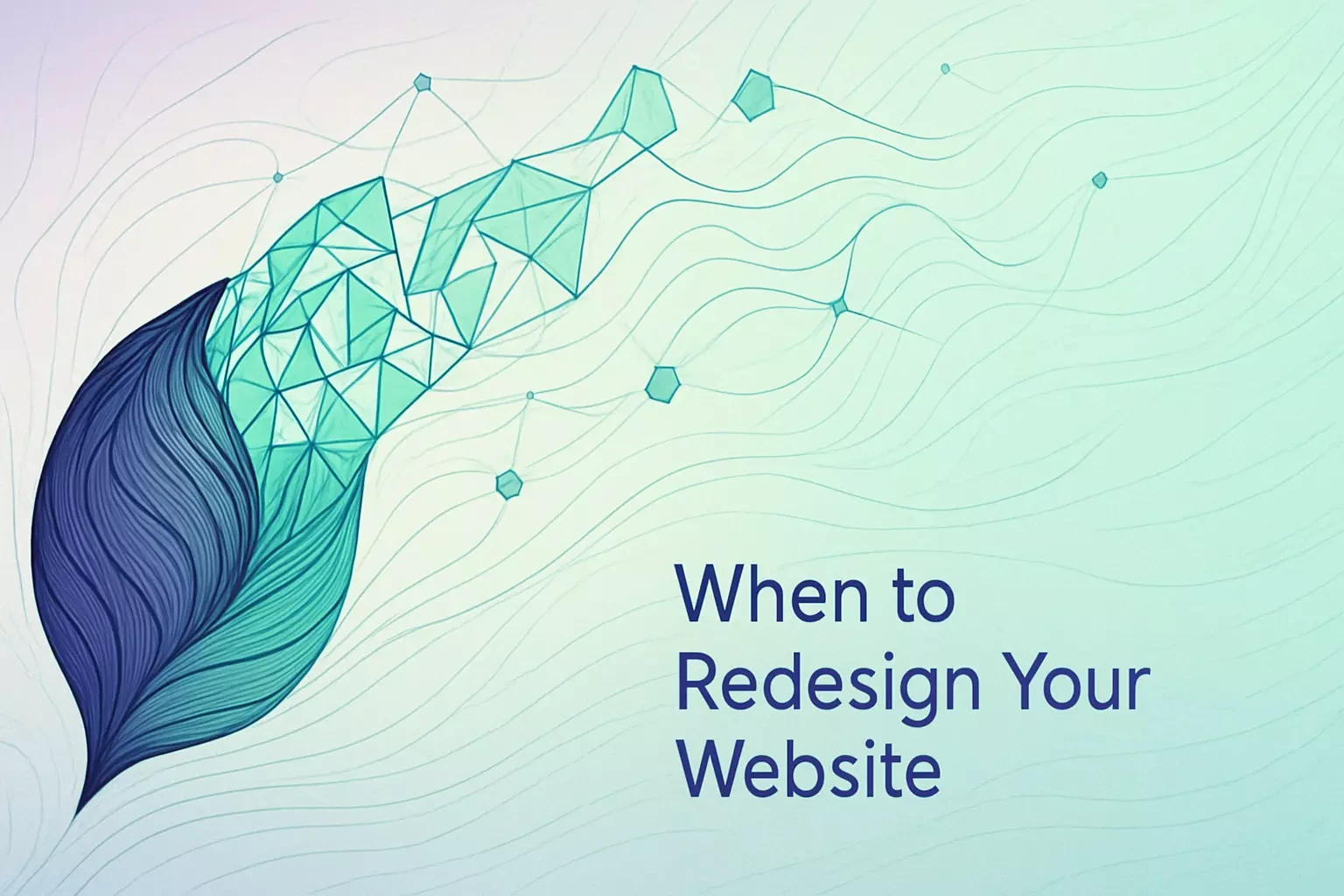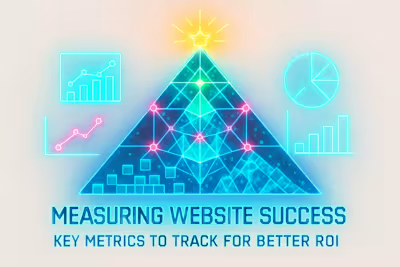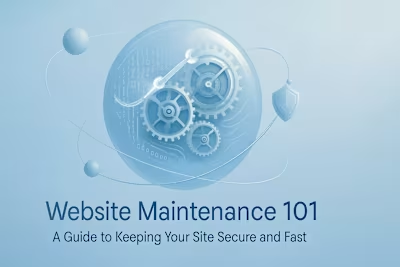When to Redesign Your Website: 7 Signs It's Time for a Refresh

When to Redesign Your Website: 7 Signs It's Time for a Refresh
Performance-Based Signs You Need a Redesign
High Bounce Rates and Low Conversions
Your Website is Slow
It's Not Mobile-Friendly
Strategic and Visual Signs It's Time for an Update
Your Design Looks Outdated
Your Branding or Business Goals Have Changed
It's Difficult to Update Your Content
Your Competitors' Websites Are Better
Planning Your Website Redesign
Start with a Website Audit
Define Clear Goals and KPIs
Focus on User Experience (UX)
Making the Decision
References
When to Redesign Your Website: 7 Signs It's Time for a Refresh
Your website is often the first impression potential customers have of your business. In today's digital landscape, that first impression can make or break a deal. A website redesign is more than just a fresh coat of paint—it's a strategic overhaul of your site's look, feel, and structure to better serve your audience and meet your business goals. While it's a significant undertaking, staying competitive often means knowing when to pull the trigger on a redesign. If you're unsure whether it's time to hire a top-tier web designer, this guide will help you recognize the signs.
The decision to redesign shouldn't be taken lightly. It requires time, resources, and careful planning. But ignoring the warning signs can cost you even more in lost customers and missed opportunities. Understanding how to measure your site's success can provide the data you need to decide if a redesign is the right next step. Let's explore the key indicators that suggest your website needs a refresh.
Performance-Based Signs You Need a Redesign
Numbers don't lie. When your website metrics start trending downward, it's like your site is waving a red flag. These performance indicators often reveal problems that go deeper than surface-level design issues.
High Bounce Rates and Low Conversions
Picture this: visitors land on your website, take one look, and immediately hit the back button. That's a high bounce rate in action. When people leave your site within seconds, it usually means something's seriously wrong with their first impression.
Maybe your homepage is confusing. Perhaps the design looks unprofessional. Or your message doesn't match what visitors expected to find. Whatever the reason, a high bounce rate signals that your website isn't connecting with your audience.
Low conversion rates tell a similar story. You might have visitors sticking around, but they're not taking action. They're not filling out contact forms, signing up for newsletters, or making purchases. This disconnect between traffic and action often points to fundamental user experience problems.
Think about your own browsing habits. When you land on a website that's hard to navigate or doesn't clearly explain what's offered, you probably leave too. Your visitors are no different. If your bounce rate is above 70% or your conversion rate is below 2%, it's time to seriously consider a redesign.
Your Website is Slow
Speed matters more than ever. Users expect websites to load in under three seconds. After that, you start losing visitors fast. Every additional second of load time can decrease conversions by up to 7%.
A slow website frustrates users and hurts your search engine rankings. Google considers page speed a ranking factor, meaning slow sites get pushed down in search results. It's a double whammy—fewer people find your site, and those who do often leave before it fully loads.
Common culprits include oversized images, bloated code, and cheap hosting. Sometimes these issues can be fixed without a full redesign. But if your site's architecture is fundamentally flawed, band-aid solutions won't cut it.
Test your site's speed using free tools like Google PageSpeed Insights. If you're consistently scoring below 50, especially on mobile, a performance-focused redesign should be high on your priority list.
It's Not Mobile-Friendly
Here's a sobering fact: over 60% of web traffic now comes from mobile devices. If your website doesn't work well on smartphones and tablets, you're essentially turning away more than half your potential customers.
A non-mobile-friendly site forces users to pinch, zoom, and scroll horizontally just to read your content. Buttons are too small to tap accurately. Forms are impossible to fill out. The whole experience becomes an exercise in frustration.
Google also penalizes non-mobile-friendly sites in search rankings. With mobile-first indexing, Google primarily uses the mobile version of your site for ranking and indexing. If that version is poor or non-existent, your visibility suffers.
Pull up your website on your phone right now. Can you easily read the text? Are buttons and links easy to tap? Does everything function properly? If you answered no to any of these questions, a responsive redesign isn't optional—it's essential.
Strategic and Visual Signs It's Time for an Update
Beyond the hard data, your website needs to align with your brand image and business strategy. Sometimes the signs are more about perception and positioning than pure performance metrics.
Your Design Looks Outdated
Web design trends move fast. What looked cutting-edge five years ago can seem ancient today. An outdated design doesn't just look bad—it actively damages your credibility.
Think about it from a customer's perspective. If a company can't keep their website current, what else are they neglecting? An outdated design suggests you're behind the times, potentially in your products or services too.
Common signs of an outdated design include boxy layouts, small fonts, Flash elements, or design trends from the early 2010s. Gradients and shadows that once looked sophisticated now scream "old website." Stock photos of people in obvious poses also date your site immediately.
As a general rule, consider a redesign every 2-3 years. This doesn't mean starting from scratch each time, but regularly refreshing your design keeps you current and competitive.
Your Branding or Business Goals Have Changed
Businesses evolve. Maybe you've expanded your services, shifted your target market, or undergone a complete rebrand. Your website needs to reflect these changes.
Using an outdated website after a rebrand is like wearing your old uniform to a new job. It sends mixed messages and confuses your audience. If your site still showcases services you no longer offer or uses old logos and color schemes, you're missing opportunities to connect with customers.
Business goal changes matter too. Perhaps you've shifted from local to national service. Maybe you're now focusing on enterprise clients instead of small businesses. Your website's messaging, design, and functionality should support these new objectives.
Take an honest look at your current site. Does it accurately represent who you are today? Does it speak to your current target audience? If there's a disconnect between your website and your current business reality, a redesign can realign your online presence with your goals.
It's Difficult to Update Your Content
Content is king, but only if you can actually publish it. If updating your website requires calling a developer for every small change, you're working with an outdated system.
Modern websites use content management systems (CMS) that let non-technical team members update text, add blog posts, and manage basic content. If you're still dealing with hard-coded HTML pages or a clunky, outdated CMS, you're wasting time and money.
This inefficiency has real consequences. Maybe you can't quickly update pricing. Perhaps publishing a blog post takes days instead of minutes. Or you avoid making necessary updates because the process is too painful.
Your website should empower your team, not hold them back. A good CMS makes content updates as easy as using a word processor. If that's not your current reality, it's time for a change.
Your Competitors' Websites Are Better
Sometimes the wake-up call comes from looking at your competition. Pull up your top three competitors' websites right now. How does yours compare?
Be brutally honest. Do their sites look more professional? Are they easier to navigate? Do they offer features yours lacks, like online scheduling or interactive tools? If you're consistently coming up short in these comparisons, you're likely losing business to them.
This isn't about copying competitors. It's about understanding the baseline expectations in your industry. If every competitor offers certain features or maintains a certain quality level, falling below that standard puts you at a serious disadvantage.
Pay special attention to user experience elements. Maybe competitors have clearer calls-to-action, better-organized content, or more engaging visuals. These differences might seem small, but they add up to a significantly better user experience.
Planning Your Website Redesign
Deciding to redesign is just the first step. Success requires strategic planning and clear objectives. A redesign without direction often results in a pretty site that doesn't perform any better than the old one.
Start with a Website Audit
Before tearing everything down, understand what you're working with. A comprehensive website audit reveals both problems and opportunities.
Start by analyzing your current site's performance metrics. Which pages get the most traffic? Where do visitors typically exit? What content generates the most engagement? This data helps you understand what's working and what needs improvement.
Don't just look at numbers. Evaluate your content quality, site structure, and technical health. Are there broken links? Is your content still relevant and accurate? How's your site's SEO performance?
User feedback is golden during this phase. Survey current customers about their website experience. What frustrates them? What features would they like to see? Their insights often reveal problems you've overlooked.
Document everything. Create a clear picture of your current site's strengths and weaknesses. This audit becomes your roadmap, helping you prioritize what to keep, what to improve, and what to completely reimagine.
Define Clear Goals and KPIs
A redesign without clear goals is like a road trip without a destination. You might end up somewhere nice, but it probably won't be where you needed to go.
Start with specific, measurable objectives. Instead of vague goals like "improve user experience," aim for "reduce bounce rate by 15%" or "increase contact form submissions by 20%." These concrete targets guide design decisions and help measure success.
Consider different types of goals. Performance goals might include faster load times or better mobile scores. Business goals could focus on lead generation or sales conversions. User experience goals might target easier navigation or clearer information architecture.
Choose KPIs that align with these goals. If you want more leads, track form submissions and conversion rates. If you're focusing on engagement, monitor time on site and pages per session. Having these metrics defined upfront prevents scope creep and keeps the project focused.
Remember to set realistic timelines for achieving these goals. Some improvements might be immediate, while others take time as users adapt to the new design. Plan to measure results at 30, 60, and 90 days post-launch.
Focus on User Experience (UX)
The most beautiful website in the world fails if users can't figure out how to use it. User experience should drive every design decision.
Start by developing detailed user personas. Who visits your site? What are they trying to accomplish? What frustrates them about the current experience? Understanding your users' needs, goals, and pain points helps create a site that actually serves them.
Map out user journeys for your main personas. How do they move through your site? What information do they need at each stage? Where might they get stuck or confused? This exercise reveals opportunities to streamline and improve their experience.
Accessibility matters too. Your redesigned site should work for everyone, including users with disabilities. This means proper color contrast, alt text for images, keyboard navigation, and clear content structure. Accessible design isn't just ethical—it's often legally required and improves usability for everyone.
Test your design concepts with real users before going live. Prototypes and mockups can reveal usability issues early when they're easier to fix. What seems obvious to you might confuse your users. Their feedback helps create a truly user-centered design.
Making the Decision
Recognizing the signs is one thing. Taking action is another. If you've identified multiple warning signs in this article, it's probably time to seriously consider a redesign.
Start by calculating the cost of inaction. How many potential customers are you losing to high bounce rates? How much business goes to competitors with better websites? Often, the cost of not redesigning exceeds the investment required for a new site.
Consider your resources. A successful redesign requires time, money, and the right expertise. If you don't have in-house design and development capabilities, you'll need to partner with professionals who understand both design and strategy.
Don't wait for the perfect moment. There's always a reason to delay—busy season, budget concerns, other priorities. But while you're waiting, your outdated site continues costing you opportunities. Sometimes the best time to start is simply now.
Remember, a website redesign isn't just about looking good. It's about creating a powerful tool that drives your business forward. When done right, a redesign pays for itself through improved performance, better user experience, and increased conversions.
Your website is too important to neglect. If you're seeing the signs discussed in this article, it's time to take action. Whether that means a complete overhaul or strategic improvements, the key is to start moving forward. Your future customers—and your bottom line—will thank you.
References
Like this project
Posted Jun 30, 2025
Is your website holding your business back? Learn to recognize the key signs that indicate it's time for a redesign, from outdated looks to poor mobile performance.











